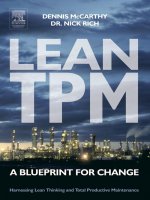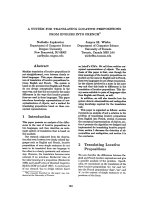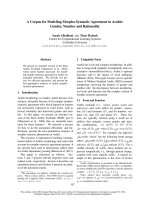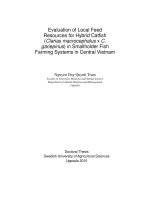AUSAID CARD project : " A BLUEPRINT FOR SUSTAINABLE SMALLHOLDER PIG PRODUCTION IN CENTRAL VIETNAM " pdf
Bạn đang xem bản rút gọn của tài liệu. Xem và tải ngay bản đầy đủ của tài liệu tại đây (431.59 KB, 93 trang )
AUSAID CARD Project 004/05
A BLUEPRINT FOR SUSTAINABLE SMALLHOLDER PIG PRODUCTION IN
CENTRAL VIETNAM
AUSTRALIAN TRAINING WORKSHOPS REPORT (6 Vietnamese Scientists June 6
th
to
July 21
st
2006)
2
SYDNEY UNIVERSITY
PROPOSED TIMETABLE FOR 1-WK VIETNAMESE VISIT
DAY ACTIVITY LEARNING OUTCOME
Sun Arrive Sydney Tour Camden to get bearings. Shop for consumables.
Mon.
am Tour & overview of Usyd piggeries
Mon.
pm
Introduction to herd recording (theory)
Using KPIs for reproduction & growth to measure pig herd performance.
Tues
am.
Herd recording systems (practical).
Tues.
pm
Environment, husbandry & management-impact on health
(theory).
The ability to assess housing, husbandry and management practices on-
farm
Wed.
am Environmental "audit" of Usyd piggeries (practical)
Wed.
pm Optimising facility throughput (theory)
An ability to assess the effectiveness of facility utilisation on a pig farm
(farm flow).
Thurs. Throughput calculation of Usyd Farm (practical)
3
Breeding herd records
Assessment
Q1. Which of the following records are vital to assess the performance of the breeding herd? (select all that
apply)
number of sows mated each week
number of sows that farrow each week
the number of times each sow is tested for oestrus
the number of sows that return to oestrus each week
Q2. What other records (other than those in Q1) should be kept to assess the mating success? (list 2)
1
2
Q3. The average farrowing rate in a herd for the year is 70%
a) Is this acceptable? Yes/No
b) How would you decide if it is a conception failure problem or a pregnancy loss problem?
Q4. The average parity of a herd is 5.5.
a) what is likely to happen to totalborn as parity of the sow increases?
it increases
it decreases
it stays the same
b) what is likely to happen to stillbirths as parity of the sow increases?
it increases
it decreases
it stays the same
c) what is likely to happen to pre-weaning mortality as parity of the sow increases?
4
it increases
it decreases
it stays the same
Q5. If a sow is weaned on a Thursday, when is she likely to come onto heat again? (select one answer)
Friday
Saturday
Sunday
Monday
Training outcomes list of competencies assessed:
Herd record keeping (Theory and practical)
Mating and farrowing
Liveborn/stillbirths/lyovers/preweaning mortality/postweaning mortality
Number of pigs/sow/year
Feed conversion ratio
Farm flow and farm throughput within the farrowing cycle
Introduction to herd health checks-assessing environment, housing, health and management
All 6 students passed their theory and practical examination.
5
PIG HEALTH AND RESEARCH UNIT BENDIGO
First week would be at Huntly Unit 6 farm of QAF (4000sows) or Castle bacon (2000 sows).
Week 2 would be at farms varying from 100-1000 sows including some deep litter systems as well.
The theory will address the relevant competency standards for certificates 2 & 3 in Agriculture, which we currently deliver to farm workers as an RTO. We will
also be looking at the economics of pig production and examining farm data from all farms we visit to determine the economic benefit of improved
performance.
Day Theory Main practical activity Ancillary activity
Sunday p.m. Performance targets.
Reproduction targets
and trouble shooting
Mon am Hands on experience in mating shed
detecting oestrus and conducting
mating
Mon p.m. Wander around the whole farm
examining all sheds and performing
autopsies on all dead pigs
Tuesday am Hands on experience in mating shed
detecting oestrus and conducting
mating
Wander around the whole farm
examining all sheds and performing
autopsies on all dead pigs
Tuesday p.m. Farrowing house
problems
Wednesday am Hands on experience in farrowing
house.
Wander around the whole farm
examining all sheds and performing
autopsies on all dead pigs
Wednesday p.m. Weaner requirements
Thursday Hands on experience in weaner shed Wander around the whole farm
examining all sheds and performing
autopsies on all dead pigs
Thursday pm Grower /finisher
requirements
Friday Hands on experience in grower
finisher shed
Wander around the whole farm
examining all sheds and performing
autopsies on all dead pigs
Friday PM Whole of farm audit
6
Monday Discuss theory on
trip to new farm
Whole of farm audit performing autopsies on all dead pigs
Monday pm Discussion on ways
to improve farm
Tuesday Discuss theory on
trip to new farm
Whole of farm audit performing autopsies on all dead pigs
Tuesady pm Discussion on ways
to improve farm
Wednesday Discuss theory on
trip to new farm
Whole of farm audit performing autopsies on all dead pigs
Wednesday pm Discussion on ways
to improve farm
Thursday Discuss theory on
trip to new farm
Whole of farm audit performing autopsies on all dead pigs
Thursday pm Discussion on ways
to improve farm
Friday Visit to abattoir for PHMS Bring back specimens
Core List of competencies (note: a hard copy of Pig Health and Research Unit training materials has been supplied)
Whole farm audits (large and small) and farm improvement
Care and nutrition of grower finisher pigs
Using digital thermometers and data recorders for monitoring shed and animal temperature and heat index
Performance targets
Conducting post mortems and identifying characteristic gross anatomical lesions of common endemic diseases
Correct techniques for collection of diagnostic specimens for laboratory investigation to support diagnosis
Pig health monitoring of abattoir material (respiratory and enteric diseases)
Vaccination schedules for breeding stock and grower pigs
Correct administration of medications and approved treatment checklists for the farrowing house, weaner, grower and finisher sheds and breeding stock.
All students passed their theory and practical component examinations.
7
APPROVED TREATMENT LIST
FARM
FARROWING HOUSE TREATMENT LIST
FARM
SOWS:
Mastitis * Sulphonamide/Trimethoprim antibiotic once daily for 3 days
* 0.5ml Oxytocin twice daily on the first day of treatment
* If not feeding piglets, give anti-inflammatory (Fluximine) once daily (max 3 days)
* Foster off small pigs and swap for large pigs
Discharge * Antibiotic (SA Penicillin) once daily for 3 days
∗ If no response, use Sulphonamide/Trimethoprim once daily for 3 days
∗ 0.5ml Oxytocin twice daily on the first day of treatment
∗ Note this will be an extensive discharge
Manuals * SA Penicillin injection once daily for 3 days
(extensive)
Off-feed * Does she have water?
* Walk the sow
* Does she have a fever? Give SA Penicillin once daily until eating
* No fever? Give milk powder/jelly crystals in feed
*Alert supervisor if she continues not to eat after 3 days
Arthritis * SA Penicillin once daily until recovery (maximum 5 days)
* Fluximine once daily until she is weight-bearing (max 3 days
* Cull if no improvement after 5 days of stopping antibiotic treatment
Prolapse * Mild-notify leading hand to suture using Lignocaine remove suture in 5 days
* Treat with SA Penicillin once daily for 3 days
* Notify manager to destroy ASAP if prolapse is severe
8
FARROWING HOUSE TREATMENT LIST
PIGLETS:
Arthritis * Short Acting Penicillin once daily for 3 days
* Disinfectant spray (eg Trublu) the area
Meningitis * Amoxycillin antibiotic (double dose 1ml/5kg) once daily for 3 days (Moxylan WHP = 14 days )
Or Treat with Long acting Amoxycillin once only
* Treat with anti-inflammatory once daily until recovery (max 3 days) (Fluximine)
Scours (E coli) * Give antibiotics for 3 days, based on Laboratory testing
(Moxylan ,Scourban, Excenel etc)
* Treat the rest of the litter with antibiotic if they look at-risk
* Electrolytes in a trough, 2-3 times daily
Scours (cocci) * To prevent outbreaks, give Baycox 1.5ml orally at 4 days of age
Pale pigs * Give 1-2ml of iron (Ferriade) orally
Greasy pig *Amoxycillin antibiotic once daily for 3 days,
* Or Treat with Long acting Amoxycillin once only
* Wash greasy pigs with iodine wash. Dry to prevent chilling
* Fluximine once daily for three days if inflammation is severe
Glassers disease
• Amoxycillin LA and Fluximine once daily for three days
• Penicillin LA at birth and 5 days of age until vaccinated pigfs come through
9
TREATMENT LIST FOR WEANERS
Meningitis * Put pig in the sick bay, supply water by hand as often as possible (40 mL/kg/day)
* Treat with Moxlan SA antibiotic ( 1ml/5kg) once daily for 3 days
* Treat with anti-inflammatory (Flunixin) once daily until recovery (max 3 days)
Arthritis * Put pigs that have difficulty walking in sick bay
* Treat with SA Penicillin once a day for 3 days
* Treat with Flunixin until weight-bearing (max 3 days)
Scouring * Amoxycillin daily for 3 days. (Scouring should stop within 12 hrs, if not switch to Trisoprim)
* Provide access to electrolytes/glucose (Bunge-lyte 32g/L) in a trough
Coughing * Treat with long acting Amoxycillin injection once .
Prolapses and
/or Tail biting * Put pig in a sick bay
* Treat with Moxylan LA once.
* Spray the affected area with disinfectant (eg Trublu)
* If severe prolapsed or pig fails to respond discuss with leading hand with a view to euthanasia
Erysipelas * Isolate the pig (where possible) to avoid infecting pen mates.
• Treat with long acting Amoxycillin and Flunixin once.
Thin/ hairy pigs.
• Place in recovery pens as soon as noticed to fall back
• Give one injection of long acting Amoxycillin
• Euthanase if no improvement after 7 days. Discuss with leading hand
Q
I3.2.1.2
10
TREATMENT LIST FOR GROWERS
Meningitis * Put pig in the sick bay, supply water by hand as often as possible
* Treat with Amoxycillin ( 1ml/5kg) once daily for 3 days
• Treat with anti-inflammatory (Flunixin) once daily until recovery (max 3 days)
• If no improvement in 3 days euthanase
Arthritis * Put pigs that have difficulty walking in sick bay
* Treat with SA Penicillin once a day for 3 days
* Treat with Flunuxin until weight-bearing (max 3 days)
* Spray any open wound the area with disinfectant (eg Trublu)
Scouring * Contact vet to discuss the cause.
• Commence treatment with Lincomycin injection daily for 3 days.
• Treat these pens last and do not contaminate other pens
Coughing * If pig looks ill treat with Lincomycin injection daily for 3 days
• Contact vet to discuss cause
Prolapses/
Tail biting * Put pig in a sick bay, euthanase if severe
* Treat with SA Penicillin.
* Spray the affected area with disinfectant (eg Trublu)
* Cull ASAP if mild
Erysipelas/
fever * Isolate the pig (where possible) to prevent infection of pen mates
* If pig looks very ill give Flunixin injection to lower temperature
• Treat with SA Penicillin injection once daily for 3 days
Fever/
Skin discoloration
* If pig looks very ill give Flunixin injection to lower temperature
• Treat with SA Penicillin injection once daily for 3 days
Thin/ hairy pigs.
• Place in recovery pens as soon as noticed to fall back
• Give one injection of long acting Amoxycillin
• Euthanase if no improvement after 7 days. Discuss with leading hand
Q
I3.2.2
Q
I3.2.3
11
TREATMENT LIST FOR FINISHERS
FARM
Meningitis * Put pig in the sick bay, supply water by hand as often as possible
* Treat with Amoxycillin ( 1ml/5kg) once daily for 3 days
• Treat with anti-inflammatory (Flunixin) once daily until recovery (max 3 days)
• If no improvement in 3 days euthanase
Arthritis * Put pigs that have difficulty walking in sick bay
* Treat with SA Penicillin once a day for 3 days
* Spray any open wound the area with disinfectant (eg Trublu)
Scouring * Contact vet to discuss the cause.
• Commence treatment with Lincomycin injection daily for 3 days.
• Treat these pens last and do not contaminate other pens
Coughing * If pig looks ill treat with Lincomycin injection daily for 3 days
• Contact vet to discuss cause
Prolapses/
Tail biting * Put pig in a sick bay, euthanase if severe
* Treat with SA Penicillin.
* Spray the affected area with disinfectant (eg Trublu)
* Cull ASAP if mild
Erysipelas * Isolate the pig (where possible) to prevent infection of pen mates
* If pig looks very ill give Flunixin injection to lower temperature
* Treat with SA Penicillin injection once daily for 3 days
Fever/
Skin discoloration
* If pig looks very ill give Flunixin injection to lower temperature
• Treat with SA Penicillin injection once daily for 3 day
12
TREATMENT LIST FOR DRY SOWS & BOARS
FARM
Discharge * Isolate and cull if these occur 14-21 days post-mating
* Otherwise, treat with SA Penicillin (non-pregnant) or Sulphonamide/trimethoprim or Tetravet 10 (pregnant) once daily until recovery (max 5 days)
Prolapses * Isolate
* Mild rectal or vaginal prolapse- Notify manager to replace & repair
* Remove stitches in 5 days
* Treat with SA Penicillin (non-pregnant) or Sulphonamide/trimethoprim or Tetravet 10 (pregnant) once daily once daily for 3 days
* destroy immediately if the prolapse is severe
Scours * Isolate where possible, and contact vet re possible causes
* Treat with tetravet 10 or Tylosin once daily for 3 days. If scouring persists, treat with Sulphonamide/Trimethoprim
* Clean and disinfect the floor to stop transmission
* Throw sawdust on the floor to make it less slippery
* Alert manager if more pigs become infected
lameness * Isolate the pig (where possible)
* Treat with Tetravet 10 or Tylosin once daily until recovery (max 5 days)
* Treat with anti-inflammatory (Flunixin) once daily until recovery (max 3 days)
* Throw sawdust on the floor to make it less slippery
* Cull or destroy if no improvement after 7 days
Erysipelas * Isolate the pig (where possible). Notify supervisor
* Clean and disinfect the floor to prevent the spread of infection
* Treat with SA Penicillin injection once daily for 3 days
* Notify your veterinarian if the infection spreads
13
14
APPROVED MEDICATIONS LIST
Drug
Trade name Dose rate With-hold period and restrictions on use
Penicillin short acting
Propen; Bomacillin
1mL/15 kg 5 days, not for use in pregnant sows
Penicillin long acting Benacillin, Bomacillin LA, Norocillin LA 1mL/15 kg 30 days
not for use in growers, finishers or
pregnant sows
Amoxycillin short acting Moxylan RTU 1mL/10 kg 14 days
Amoxycillin long acting Bomox LA, Moxylan LA 1mL/10 kg 28 days
not for use in growers or finishers
Apramycin Apralan Suckers 25 mg/kg
Weaners 12.5 mg/kg
14 days
Toltrazuril Baycox 1.5 mL/pig 100 days
Ceftiofur Excenel (only in scouring pigs greater than
5 days of age)
1mL/15 kg 5 days
Tolfedine CS One injection lasts 48 hrs 1mL/ 20 kg 6 days
Flunixil Fluximine 1mL/ 20 kg 28 days
Scourban Scourban 2mL/3kg orally 14 days
Lincomycin Lincomix 1mL/30 kg 3 days
Flunixin Fluximine 1mL/20 kg 14 days Not for use in finishers
Trimethoprim TMPS 240 1mL/15kg 15 days
Tylan Tylopharm 200 1mL/20 kg 14 days
Lincomycin Lincopharm 800 10mg/kg or 10 g/ 1000 kg of pigs. 48 hours
15
Give in water for 2 days every 14 days to
growers and Finishers for Ileitis control
16
Suggested itinerary for 6 visiting trainee scientists from Vietnam. SARDI
WEEK ONE
Day Theory and Practical Trainers
Mon am Introduction to Roseworthy Campus and
South Australia
Cargill / Murphy
Mon pm Outline of training programme
Pig Production in South Australia
Health and production monitoring
Visit to PPPI Piggery
Cargill / Murphy
Tuesday Health and production monitoring
- farm visits
Cargill / Moore
Wednesday Health monitoring at abattoir
Examining specimens
Health and production monitoring
review
Jackowiak
Jackowiak / Moore / Cargill
Thursday Housing - monitoring and assessing
hygiene, thermal environment, and air
quality within houses and problem
solving
Banhazi / Murphy / Cargill
Friday Housing - monitoring and assessing
hygiene, thermal environment, and air
quality within houses
Problem solving,
Farm and shed audits for hygiene and
thermal environment.
Banhazi / Murphy / Cargill
WEEK TWO
Day Theory and Discussion Trainers
Monday Reproduction
- managing gilts
- problem solving reduced conception
and farrowing rates
Hughes
Tuesday AI - both theory and practice Pope
Wednesday Food safety and hygiene
- research and development
Pointon et al
Thursday am Waste management
Developing and managing Biosystems
Glatz / Santhanam / Banhazi
Friday General Review
APIQ and Welfare
Cargill / Moore / Pope /
Banhazi / Murphy
Friday Evening
FAREWELL in the “Feed Lot” Everyone
17
18
SARDI
HYGIENE AND AIR QUALITY INDEX
(Assessing sheds to predict hygiene and air quality)
Owner/manager:…………………………………………………………………….……
……
Address:……………………………………………………………………………………
…
.
………………………………………………………………………………………………
….
Telephone:…………………………………… Fax:……………………………………
……
E-
mail:……………………………………………………….………………………………
…
Number sows:…………………
HAQ INDEX SCORE SHEET
Pass/fail
√/ X
Management and production
Shed dimensions
Ventilation
Heating and Cooling
Shed environment
19
Effluent system
TOTAL
20
STEP 1
MANAGEMENT AND PRODUCTION SYSTEM
Points
Farrowing system
Batch farrowing (2)
- Length between batches (<2 wks = 1; > 2 wks = 2)
- AIAO with cleaning (1)
- AIAO without cleaning (0)
Continuous-flow farrow to finish (-1)
2
1 / 2
1
0
-1
Weaner/grower/finisher
ASR/SEW (2)
Multi-site (2)
AIAO by shed (2)
AIAO by room (2)
AIAO by section (1)
3 phase CF (weaners/growers/finishers separated) (2)
2 phase CF (weaners separated from grower/finishers) (-1)
1 phase CF (weaners/growers/finishers housed together) (-2)
2
2
2
2
1
0
-1
-2
TOTAL max score ( 5 + 6 = 11)
21
Notes for step 1:
Record type of production system used on the farm by circling the figure in the score
column.
Add circled scores to calculate "Total score".
If total score is more than 6 – production system is OK.
Essentially a batch-farrowing system with aged segregated rearing is regarded as best
practice. Continuous farrowing with all-in/all-out weaner and growing pig housing is the
next best approach
22
STEP 2
SHED DIMENSIONS Points
Pens
Width (PW)….…… Length (PL)….……
Pen area (PA) = W……….X L….……=… …….m
2
Total slats (yes/no)
Partial slats – Slatted area = (length……….X width….…… = ……….
m
2
)
Shed
Width (SW)… …
Length (SL)… …
Average Height (SH)… …
Shed volume (SV) = SW……….X. SL… X SH…… = …….…
m
3
(SV)
Pigs
Average pigs/pen (Pi)……….
Number pens (Pn)…………
Total pigs /shed (PN) = Pi ……….X Pn……….= ……….
Stocking rate = PA/Pi ………… ….=…….…….(SR)(m
2
/pig))
Stocking density = SV/PN………… = ………….(SD) (m
3
/pig)
23
Scoring
Width shed (> 12 m = -2; if 10-12 m = 0; if 10 m = 2)
Length shed ( > 30 m = 0; < 30 m = 1)
SR - (> 10% above recommended SR = -2; if < 10% above
recommended = 0
if < recommended SR = 2)
SD - (> 10% above recommended SR = -2; if < 10% above
recommended = 0
if < recommended SR = 2)
-2 / 0 / 2
0 / 1
-2 / 0 / 2
-2 / 0 / 2
TOTAL (Max score =7)
See next page for notes to step 2
24
Notes for step 2:
Measure width and length of pens and shed. Include aisles in shed dimensions.
To obtain average height – measure height from floor to roof midway between apex and
wall.
In some old sheds, where sheds have been added on, it is often easier to measure the shed
in sections.
If you wish you can ignore the length of the shed when scoring. This mainly applies to
continuous flow operations where there are mixed age groups and respiratory disease.
As with step 1, circle scores that apply to the shed and add circled scores.
A score of zero or more is for width and length is OK – a score of less than zero indicates
problems.
A score of less than 0 for either stocking rate or stocking density indicates a significant
problem.
Recommended stocking levels for growing pigs
Final Average
Weight (Kg)
Stocking rate (square
metres/pig)
Stocking density** (cubic
metres/pig)
Up to 11 0.17 -
Up to 18 0.22 -
Up to 27 0.27 -
Up to 35 0.38 1.60
Up to 50 0.49 2.10
Up to 70 0.60 2.60
Up to 100 0.80 3.00
**To measure the stocking density:
1. Measure the width, length and height of the shed (height is measured mid way from
the wall to the centre of the shed)
2. Multiply height by width by length = volume in cubic metres.
3. Count the number of pigs in the shed.
Divide the number of cubic metres by the number of pigs = stocking density.
25
STEP 3
VENTILATION Points
Side wall
Height (H)……… . Length (L) ……… . Shed width
(SW)……………
Height of sidewall opening (HS) …………. .
HS/SW X 100 = ……………%
Ridge vent
Width (RVW)…………;RVW/SW%…………….(target 10%)
Cap height (RVCH)………;RVCH/SW%………….(target 5%)
Angle of roof pitch (AR)
> 15 degrees (Yes/No)
Scoring
HS/SW% (if <8% = -2; if 8-10% = 0; if >10% = 2)
RVW/SW% (if < 10% = -2; if = or > 10% = 2)
RVCH/SW% (if < 5% = -2; if = or > 5% SW = 2)
AR (if < 15 degrees = -2; if > 15 degrees = 2)
If side openings and ridge vent openings independent = (1 bonus)
Automated (2)
Refresh cycle (2)
-2 / 0 / 2
-2 / 2
-2 / 2
-2 / 2
(1)
2
2
Total (max score = 12)
Notes for step 3









